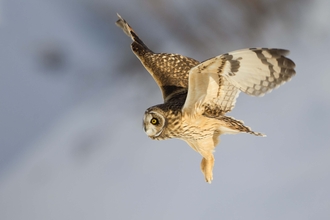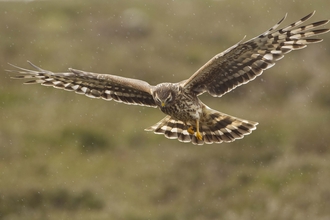There’s a real atmosphere at Fenn’s & Whixall when the reeds and rushes are edged with frost and your breath hangs white in front of you, and you’re totally alone in acres of frozen wetland. The usually squelchy paths crunch under your boots, ice on the puddles reflects a cold blue sky, and no bird sings. No dragonflies today, no chance of an emperor moth or a raft spider, but the mosses have a winter magic all of their own.
I’m hoping for a winter visitor – a short eared owl. These silent-flying yellow-eyed creatures come to the mosses in winter from their moorland breeding grounds and are seen regularly on Whixall Moss. Maybe voles are easier to catch here – these birds are specialist field vole hunters, unlike the less-choosy barn owls which seem to prey on anything that moves, as long as it’s an appropriate size. The brown, grey and white plumage of the short-ears blends with the frosted sere vegetation perfectly and only their movement gives them away. They quarter the ground, hunting in daylight during winter, as in this season voles are more active during the day. Maybe from the Mammoth Tower I’ll be able to watch a hunt, the slow, leisurely, rather wavering flight with frequent turns and glides, the momentary lift of the wings into a shallow V shape, the focus of all senses on the ground, then yes! The feet-first plunge to secure the prey. Luckily there are plenty of voles to go around – with a population of 75 million they’re one of the commonest mammals in the UK.
Another winter migrant to the mosses I’ll be looking out for is the hen harrier. These are often recorded on the mosses in winter, their long wings and light build giving them a buoyant flight as they quarter the extensive wetland, hoping to flush a small bird. Females and immature birds are hard to tell apart, brown above and streaky below, with a white rump and a banded tail, so often referred to as ring-tails. The real prize, for me, would be an adult male, resplendent in blue-grey and showing off black wing tips with his classic dihedral wing position. The upward angle of the wings, I’m told, gives lateral stability – a feature adopted in aircraft design, which means they are more stable when rolling left or right. Certainly the harriers are true masters of flight. We won’t get to see their famous sky-dancing display here but it would be a great day out to follow them to their breeding grounds in North Wales when the time comes. For now, I’ll be happy just to catch sight of such a rare and beautiful raptor.
I won’t be down-hearted if I miss out on the owls and harriers though. There will be plenty more to see – winter wildfowl on Sinker’s Fields, maybe a kingfisher along the canal, perhaps a murmuration of starlings as the light fades. And another frosty day will always lure me out for another chance!



